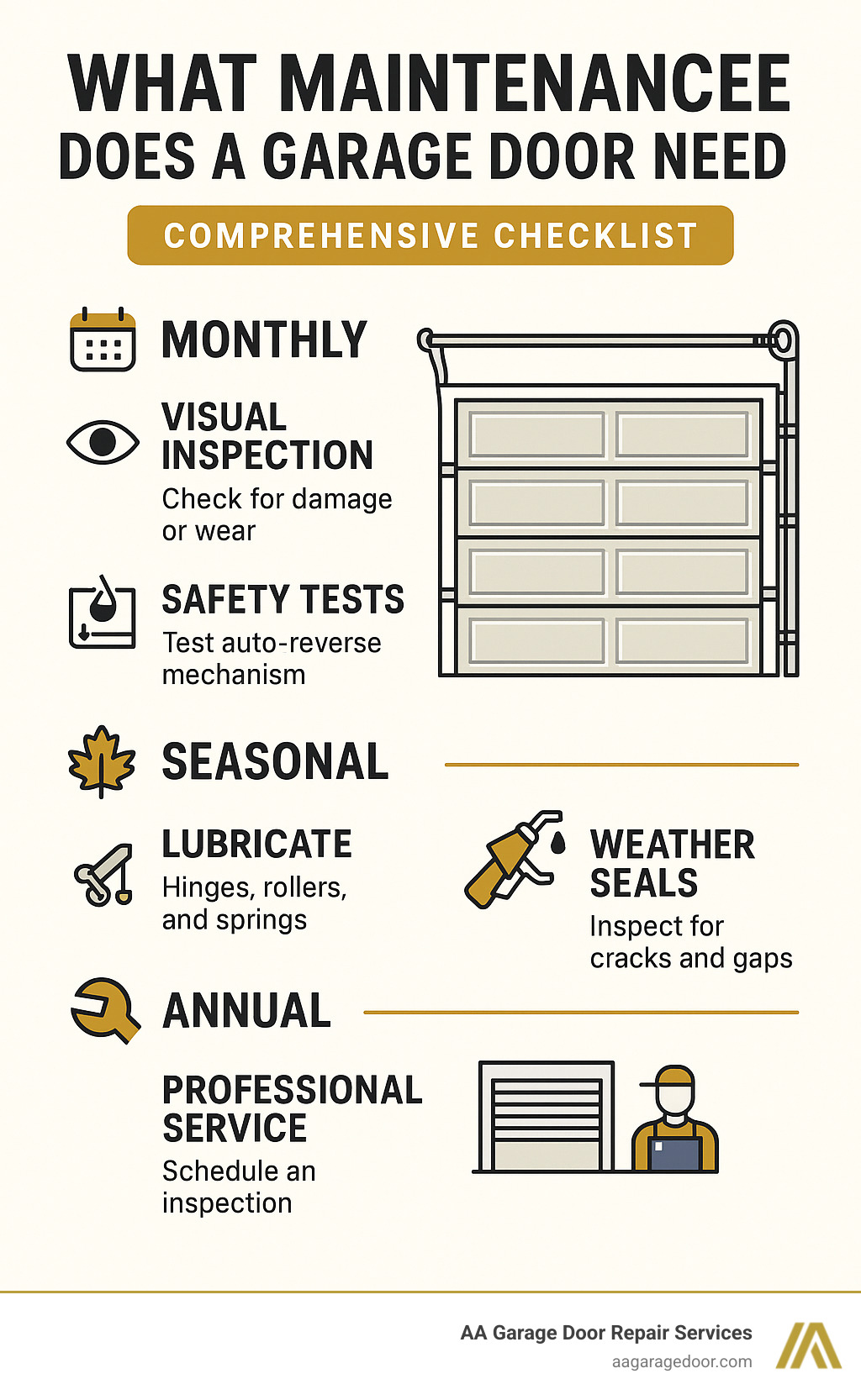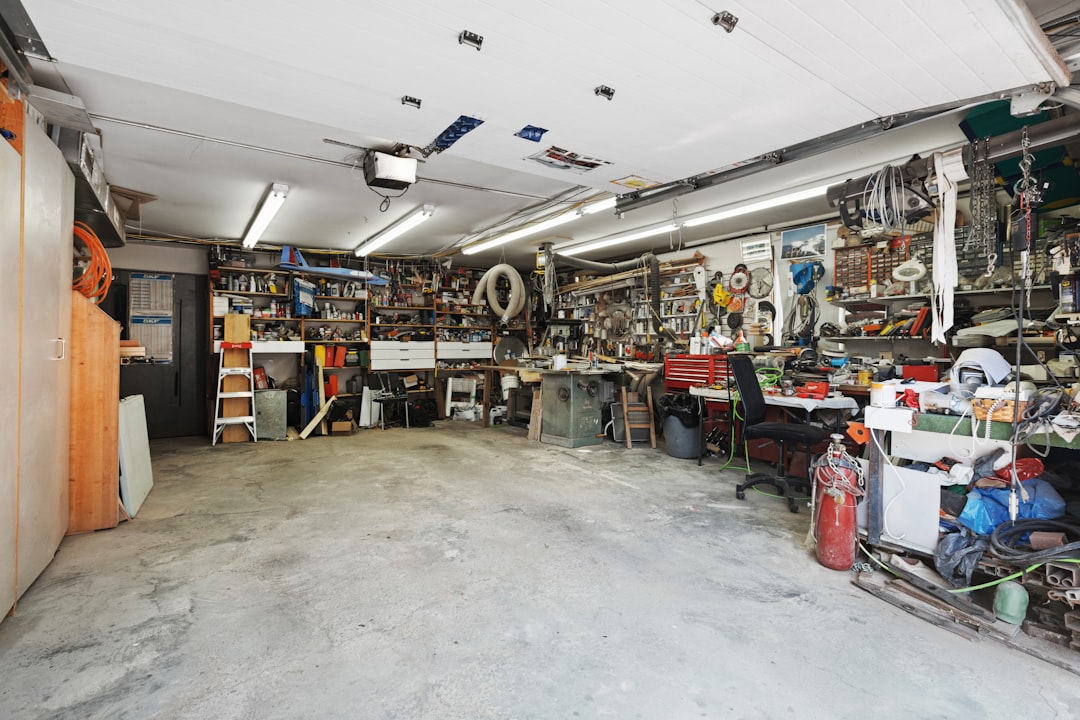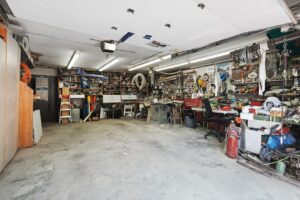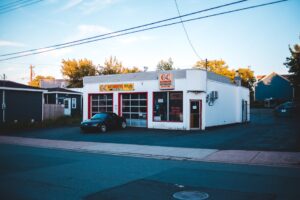Why Garage Door Maintenance Matters More Than You Think
What maintenance does a garage door need is a question every homeowner should ask. Your garage door is one of the hardest-working systems in your home, cycling up to 1,500 times per year, yet most people only think about it when something goes wrong. Proactive care is essential for safety, security, and avoiding costly repairs. For homeowners seeking professional garage door services in the Twin Cities, understanding these basics helps you make informed decisions about your door’s care.
Essential garage door maintenance tasks include:
- Monthly visual and auditory inspections – Check for unusual sounds, jerky movements, or visible damage.
- Safety testing – Test the auto-reverse mechanism and photo-eye sensors monthly.
- Lubrication – Apply white lithium grease to hinges, rollers, and springs twice yearly.
- Hardware tightening – Check and tighten loose bolts, nuts, and brackets.
- Track cleaning – Remove debris and wipe tracks clean.
- Weather stripping inspection – Replace cracked or worn seals.
- Professional tune-ups – Schedule annual inspections for complex components like springs.
The stakes are high. Over 18,000 garage door accidents occur annually in the United States, many preventable with proper maintenance. A well-maintained door can last 15-20 years, while neglected doors often fail in half that time. Regular maintenance isn’t just about avoiding repairs; it’s about protecting your family, maintaining home security, and ensuring reliable access to your garage.

The Core of Garage Door Health: A Visual and Auditory Inspection
Understanding what maintenance does a garage door need begins with monthly check-ups. Your garage door operates thousands of times a year, and a simple “look, listen, and feel” approach can save you from costly surprises. Taking ten minutes each month to observe your door in action is an investment in its longevity.
One of the most revealing checks is the door balance test. Disconnect the opener (pull the red cord) and lift the door manually. It should glide smoothly and stay put when you let go halfway up. If it’s very heavy or slams down, the springs need professional attention.
Identifying problems early is your secret weapon. A slight grinding sound or a door that hesitates are not quirks to ignore—they are calls for help. For comprehensive guidance, our Pro Tips for Maintaining and Repairing Your Garage Door offers deeper insights.
What to Look For: A Component-by-Component Checklist
During your visual inspection, check these parts:
- Springs: Look for gaps, rust, or breaks in the coils of torsion or extension springs. If you see damage, call a professional immediately. These parts are under extreme tension.
- Cables: Check for fraying, rust, or broken strands. Damaged cables are a serious safety hazard and require professional service.
- Rollers: Worn rollers can make your door work much harder. Steel rollers may wobble, while nylon ones can crack. Most need replacement every 5-7 years. Learn more about Garage Door Rollers.
- Tracks: Tracks should be straight and clean. Small bends or debris can disrupt the door’s operation.
- Hinges and Hardware: Loose bolts are a common cause of noise. Tighten what you can, but never touch hardware painted red, as it indicates high-tension components.
- Weatherstripping: Cracks or gaps in the seals around the door let in weather and pests. If you see daylight, it’s time for new seals.
- Door Panels: Look for dents, rust, or warping. Steel doors may need touch-up paint, while wood doors might have weather damage.
What to Listen For: Decoding Your Door’s Sounds
Your garage door’s sounds tell a story. A healthy door should have a consistent, quiet rhythm.
- Grinding Noises: Often means dirt in the tracks, worn rollers, or failing opener gears.
- Squeaking or Screeching: Usually a cry for lubrication on metal hinges, rollers, or springs.
- Popping Sounds: This is a serious warning, often signaling a broken spring. If you hear a loud pop, stop using the door and call a professional.
- Jerky Movements: Indicates balance issues, bent tracks, or roller problems.
If your door has developed new sounds, it’s telling you something important. For solutions to common noise problems, our Noisy Garage Door Fix guide can help.
What Maintenance Does a Garage Door Need? A Step-by-Step DIY Guide
Now it’s time for some hands-on maintenance. These simple steps are the backbone of what maintenance does a garage door need to keep running smoothly.
Safety first! Always unplug your automatic door opener. If working with the door up, clamp a locking plier on the track just below a roller to prevent it from sliding down.
Your toolkit is simple: a socket wrench, screwdrivers, rags, and the right lubricants. These tasks are best done annually, with lubrication performed twice a year (spring and fall). For a quick reference, check out our 6 Tips to Maintain Your Garage Door.
Lubrication: The Secret to Smooth Operation
Lubrication is the most important DIY task for understanding what maintenance does a garage door need. It makes an immediate difference in noise and performance.
Use the right lubricant: white lithium grease is best for metal-on-metal parts like hinges and roller bearings. For springs and weatherstripping, use a silicone spray or penetrating oil. Never use WD-40 as a long-term lubricant; it’s a degreaser that attracts dirt.
Apply lubricant to hinge pivot points, metal rollers (not nylon ones), and springs. Spray springs generously to reduce friction and prevent rust. Never lubricate the tracks; they must be clean for rollers to roll properly. For more on this topic, you can explore more on lubricants.
Cleaning and Tightening: The Unsung Heroes of Maintenance
Cleaning and tightening prevent most common garage door problems.
- Clean the Tracks: Use a brush or shop vacuum to remove debris. Wipe the tracks with a rag and a degreaser. Clean tracks allow rollers to glide effortlessly.
- Tighten Hardware: The door’s vibration can loosen bolts over time. Use a socket wrench to snug up all visible hardware on hinges and brackets. Be careful not to overtighten.
- Safety Warning: Never touch any hardware painted red or the bottom roller fixtures. These are under extreme spring tension and require a professional.
- Check Weatherstripping: Inspect the rubber seal at the bottom of the door and around the frame for cracks or gaps. If you see daylight, it’s time for replacement. Our guide on garage door weather stripping can help.
- Clean Door Panels: Use mild detergent for steel and aluminum doors, and a dry cloth for wood doors. This also helps with pest prevention, as well-sealed doors keep critters out. For more tips, see how to keep pests out.
Essential Safety Checks You Can’t Afford to Skip
While smooth operation is important, your garage door’s safety features are paramount. A sobering fact: more than 18,000 accidents involving garage doors occurred in the United States in 2014 alone. Many could have been prevented.
Since 1993, federal law has mandated that automatic openers have a reversing mechanism and a photo-eye sensor. Regularly testing these features is a critical part of what maintenance does a garage door need.
These checks save lives. For more information, visit our Garage Door Safety guide and the Care & Maintenance – IDA page.
Testing the Auto-Reverse Mechanism
The auto-reverse mechanism prevents the door from crushing an object. Test it monthly.
- The 2×4 Test: Place a 2×4 board flat on the ground in the door’s path. When closing, the door should hit the board and immediately reverse. If it doesn’t, the mechanism is faulty and needs professional service. Do not use the door until it is repaired.
- Force Setting Test: As the door closes, place your hands under it to apply gentle resistance. The door should easily reverse without applying excessive force. If it doesn’t, the force setting is too high and requires professional adjustment.
For more on critical repairs, see our Essential Guide to Garage Door Repair Keeping Your Door Safe and Functional.
Checking the Photo-Eye Sensors
Photo-eye sensors create an invisible beam at the bottom of the door opening. If the beam is broken while the door is closing, it should reverse.
- How They Work: Two small units are mounted near the floor. One emits an infrared beam, and the other receives it.
- The Wave Test: As the door closes, wave an object (like a broomstick) through the sensor’s path. The door should immediately stop and reverse. If it fails, check for obstructions.
- Cleaning and Alignment: Dust and cobwebs can block the lenses. Wipe them with a soft, dry cloth. The sensors must be perfectly aligned to work; most have an indicator light that glows steadily when aligned. Gently adjust a sensor if the light is off or flickering.
- Troubleshooting: If cleaning and alignment don’t fix the issue, you may have a wiring problem or a faulty sensor. Call a professional and never bypass the sensors. Our guide on Common Reasons for Garage Door Sensor Troubles can help.
When to Call a Pro: Recognizing the Red Flags
While DIY maintenance is valuable, some garage door repairs are too dangerous to attempt yourself. Certain components are under extreme tension and require specialized tools and experience to handle safely.
Knowing what maintenance does a garage door need from a professional is non-negotiable for certain issues. We recommend an annual professional tune-up, even if your door seems fine. A trained technician can spot subtle problems and perform precision adjustments, preventing major headaches later. For a reality check on which repairs to avoid, see our guide on 3 Garage Door Repairs Best Left for the Professionals.
What maintenance does a garage door need from a professional?
These red flags require an immediate call to a professional:
- Broken springs: A loud “pop” followed by a door that won’t lift is a classic sign. Do not attempt to operate the door.
- Frayed or broken cables: These are under tremendous tension. If they look damaged or have snapped, step away and call for help.
- Severely bent tracks: Attempting to hammer tracks straight can cause the door to derail completely, a very dangerous situation.
- A door off its tracks: This requires careful realignment and spring tension adjustments that are unsafe for DIY.
- Opener motor problems: Grinding noises, inconsistent operation, or total failure often need professional diagnostic tools to solve.
For any of these complex issues, our experienced team provides expert garage door repair services throughout the Twin Cities area.
The Dangers of DIY Spring and Cable Repair
Let me be crystal clear: attempting to repair or adjust garage door springs or cables yourself is extremely dangerous. The springs store enough force to lift a 200-pound door, and when they fail, they release that energy violently. The potential for serious injury is very real, as documented by Consumer Affairs reports on serious injury from DIY attempts.
Professionals use specialized tools like winding bars to handle these components safely. Most springs last 5 to 12 years (about 10,000 cycles). When one breaks, the other is likely near failure, which is why we always replace them in pairs. Whether you have torsion or extension springs, both are hazardous. Professional spring replacement is worth every penny for your safety.
What maintenance does a garage door need for the opener?
Your opener is the brain of the system and needs attention. Recognizing what maintenance does a garage door need for the opener can prevent you from being stranded.
- Motor burnout signs: A struggling sound, grinding noises, or a burning smell indicate your motor is overworked, often due to an unbalanced door.
- Grinding or humming: This often points to worn internal gears, especially in older openers with plastic parts.
- Opener stops responding: Check batteries first. If that fails, it could be a wiring issue, sensor problem, or internal malfunction.
- Frequent, unexplained reversing: This could be misaligned photo-eyes, incorrect force settings, or a faulty logic board.
If your opener is old (pre-1993), consider upgrading to a newer model with modern safety features. For complex opener issues, our team can quickly diagnose and fix the problem.
Frequently Asked Questions about Garage Door Maintenance
Here are answers to common questions we receive from homeowners about what maintenance does a garage door need.
How often should I perform garage door maintenance?
A good routine includes monthly DIY checks (visual inspection, listening for noises, safety tests), seasonal lubrication (twice a year), and an annual professional tune-up. If your door gets heavy use (more than 4-5 cycles daily), consider more frequent checks.
What is the most important maintenance task I can do myself?
If you only do two things, make them testing the safety features and lubricating moving metal parts. Testing the auto-reverse and photo-eyes is a five-minute task that prevents tragic accidents. Lubrication with white lithium grease or silicone spray reduces friction, prevents wear, and ensures quiet, smooth operation.
Can I replace my own garage door springs?
No. We strongly advise against it. Garage door spring replacement is not a DIY project. The springs are under extreme tension and can cause severe injury or death if they snap or are handled improperly. Professionals use specialized tools and training to perform this job safely. It’s a repair where the cost of professional service is a small price to pay for safety.
Conclusion
Understanding what maintenance does a garage door need is about more than just convenience; it’s about protecting your family’s safety, your home’s security, and your wallet. A little attention goes a long way.
The monthly inspections, regular lubrication, and crucial safety checks we’ve covered can add years to your door’s life and prevent sudden failures. Most of these tasks take just minutes each month.
However, knowing your limits is just as important. When you see frayed cables, hear a broken spring, or have a door that’s struggling, it’s time to call in the professionals. Some repairs are simply too dangerous for even the handiest DIY enthusiast.
For homeowners throughout St. Paul, Minneapolis, the Twin Cities, and Western Wisconsin, our team at AA Garage Door has been helping families keep their doors running safely since 2001. We handle everything from routine tune-ups to emergencies.
Don’t let a small problem become a big headache. Schedule your garage door maintenance service today. Your garage door works hard for you; returning the favor with proper care ensures it will keep working reliably for years to come.









